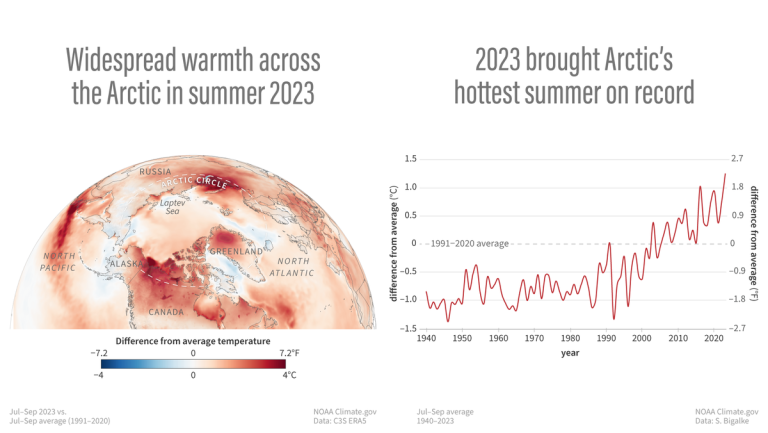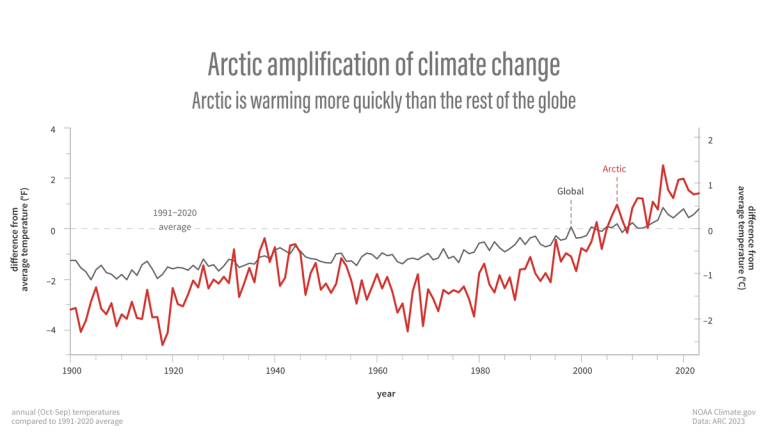Arctic Report Card documents evidence of accelerating climate change
The US National Oceanic and Atmospheric has issued its annual Arctic Report Card. It documents new evidence that warming of the air, ocean and land is affecting people, ecosystems and communities across the Arctic region, which is heating up faster than any other part of the world.

Summer surface air temperatures during 2023 were the warmest ever observed in the Arctic. Overall, it was the Arctic’s sixth warmest year on record. Sea ice extent continued to decline, with the last 17 Septembers now registering as the lowest on record.
Unusual warmth in Greenland contributed to a cumulative melt-day area approaching the all-time record on the Greenland Ice Sheet. The highest point on Greenland’s ice sheet experienced melting for only the fifth time in the 34-year record.
Unusual warmth in northern Canada coincided with below-normal precipitation, contributing to the region’s extreme wildfire season and resulting smoke in the United States.

The annual Arctic Report Card, now in its 18th year, is the work of 82 authors from 13 countries. It includes a section titled Vital Signs, that updates eight measures of physical and biological changes, four chapters on emerging issues and a special report on the 2023 summer of extreme wildfires.
The Arctic Report Card provides important knowledge to inform WMO’s State of the Climate monitoring activities in the Arctic region.
“The overriding message from this year’s report card is that the time for action is now,” said Dr Rick Spinrad, NOAA administrator. “NOAA and our federal partners have ramped up our support and collaboration with state, tribal and local communities to help build climate resilience. At the same time, we as a nation and global community must dramatically reduce greenhouse gas emissions that are driving these changes.”
“Arctic amplification” is a widely recognized phenomenon in which human-caused global warming is amplified at the poles, causing the Arctic to warm more quickly than the rest of the globe. Multiple factors enhance warming at high latitudes, but the main one is that warming reduces snow and ice, which would otherwise reflect incoming sunlight. Arctic temperatures have risen at least twice as fast as global temperatures, possibly even faster, since the year 2000.

The shallow seas around the margins of the Arctic Ocean have warmed dramatically in the past four decades. On average, these areas have warmed around 2° C (nearly 4 °F) over the satellite era, part of a feedback loop in which warming air and water temperatures shrink the sea ice cover, which exposes more of the ocean to direct sunlight, which drives more warming.
Places that were once snow-covered nearly year round are thawing out earlier in the spring. Winter 2022-23 actually brought above-average snow accumulations to the Arctic, but it disappeared much more quickly in the spring than it used to.
Highlights
- The average surface air temperature in the Arctic this past year was the sixth warmest since 1900.
- This year’s sea ice extent was the sixth lowest in the satellite record, which began in 1979. The 17 lowest Arctic sea ice extents on record occurred during the last 17 years.
- Many Arctic Ocean regions continue to show increased ocean phytoplankton blooms.
- The Greenland Ice Sheet continued to lose mass despite above-average winter snow accumulation.
- Pan-Arctic precipitation was the sixth highest on record, continuing the trend toward a wetter Arctic.
- Warming has had divergent impacts on different Alaska salmon runs: some have had record-high abundance and others record-low abundance.
Although the Arctic tundra is mostly too cold and dry for trees, it’s home to other plants that have evolved to survive the frigid winters and short growing seasons on the Arctic’s coastal plains and foothills. Sandwiched between the boreal forests and the ocean, this area of shrubs, mosses, lichens, grasses, and grass-like plants called sedges grow in the relatively thin layer of soil that thaws out briefly in the Arctic summer. As the Arctic has warmed over the past several decades, satellites have documented a significant “greening” of the tundra.
- WMO Member:
- United States of America










